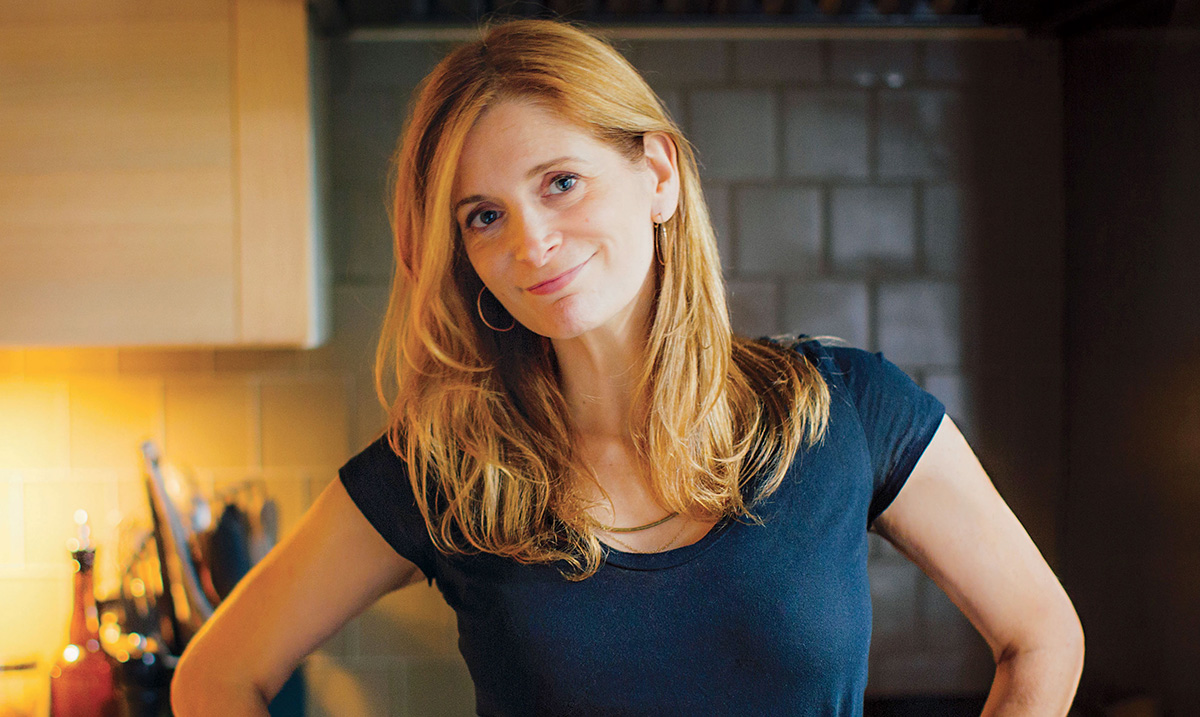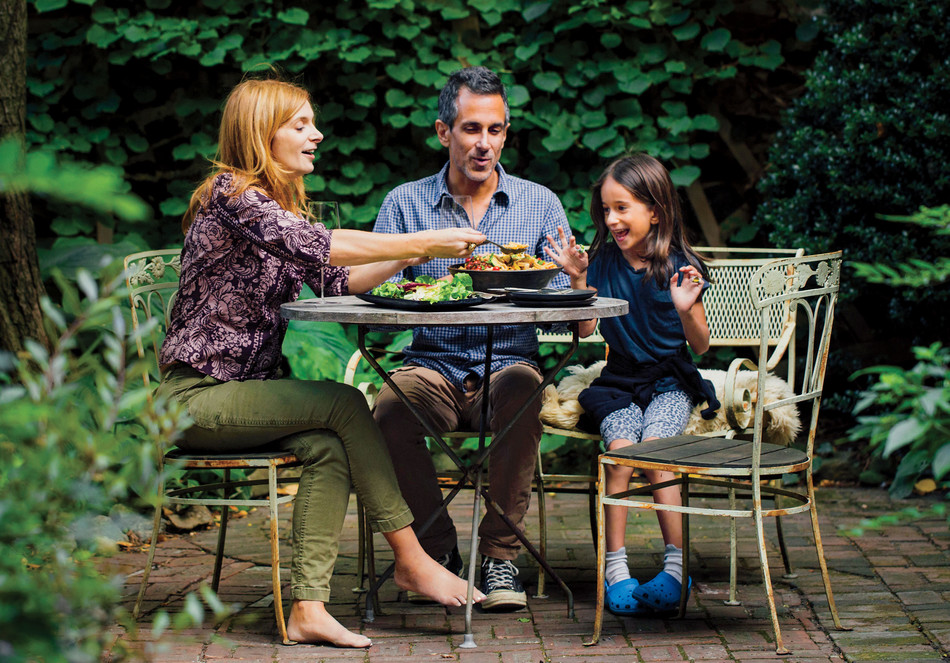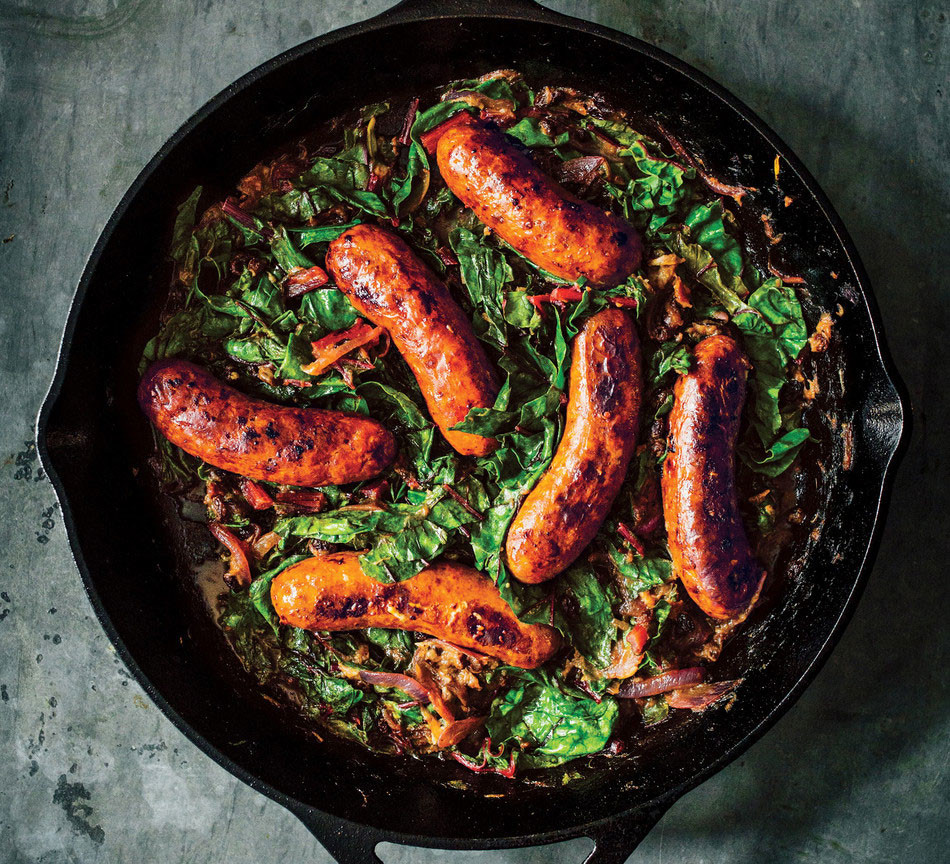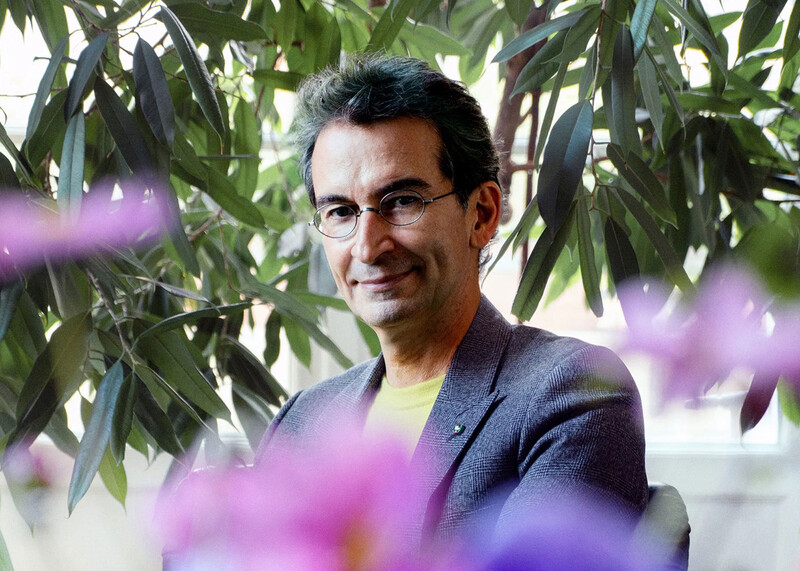
It’s a Tuesday morning at Brooklyn’s Runner & Stone bakery, and Melissa Clark ’90BC, ’94SOA is in line, holding court.
A layer of fog hovers over the gritty Gowanus Canal nearby, but the bakery is airy and warm. Clark, like a cat, has found the sunniest table, and she’s placed her order — a buckwheat baguette, extra butter, and a latte with plenty of sugar. Now she’s chatting up the other customers, selling them on the surprisingly nutty texture of the buckwheat and the fact that the bakery uses rich European butter. She talks quickly and emphatically, and by the time the other customers have reached the cash register, they’re transfixed by this preternaturally cheerful woman with the broad smile and the mane of red hair. Many abandon their original orders and decide to mimic Clark’s.
“I can’t seem to help myself,” she says. “You’d think I was on the payroll.”
In fact, Clark has nothing at stake. She just loves food, to the point of evangelism. And if there’s a way to make a meal better — even an ordinary Tuesday breakfast — she wants to share it with the world.
Clark’s new friends may not recognize her, but odds are they’ve made one of her recipes. She’s written the weekly column A Good Appetite in the New York Times’s dining section for more than a decade, and a search of NYT Cooking, the paper’s digital culinary hub, finds nearly a thousand recipes attributed to her. She’s also written or collaborated on a mind-boggling thirty-eight cookbooks. This spring, she released her latest — Dinner: Changing the Game, a collection of what Bon Appétit called “over 200 why-didn’t-I-think-of-that recipes.”
Clark is known for pairing basic, easily mastered cooking techniques with new and interesting ingredient combinations, giving home cooks vastly more options. For example, Dinner includes eight different recipes for roast chicken: one with sherry vinegar and grapes; one with smoky paprika, crispy chickpeas, and kale; and so on. Once readers are comfortable roasting a chicken, they suddenly have eight dishes in their arsenal. Quick pizza dough (store-bought is also fine) gets topped with butternut squash, pecorino, and roasted lemons — a sophisticated alternative to tomato and mozzarella for the same amount of work.
One dinner game-changer, Clark says, is keeping a well-stocked pantry. She suggests, for example, that home cooks invest in a jar of harissa, a North African chili paste that she uses in a chicken dish with leeks and potatoes, a slow-roasted tuna with olives, and a spicy baked shrimp with eggplant and mint. Pomegranate molasses — a staple of Middle Eastern cuisine — finds its way into chicken breasts with walnut butter, roasted tofu and eggplant, and peachy pork with charred onion.
“People really get into a cooking rut, thinking that they can only make five or ten different recipes. There’s that beef thing they make. Or that chicken thing,” Clark says. “But my book has twenty-six chicken things. And most of them are riffs on the chicken thing you already know how to make.”
This is not to say that Clark expects, or even wants, people to follow her blindly. She loves it when people tell her not only that they’ve made her recipes, but how they’ve adapted them to their own palates. The recipes are meant to be jumping-off points, totally functional as written, but always open to what she calls, very technically, “futzing.”
“I see myself as a guide,” Clark says. “Everyone has a thing. Mine’s just always been food.”
Clark grew up in Ditmas Park, Brooklyn, in the seventies and eighties, in a house where meals were cherished and Julia Child’s Mastering the Art of French Cooking was like a family Bible. Clark’s parents — both Columbia-trained psychiatrists — were enthusiastic home cooks who teamed up to host dinner parties nearly every weekend.
“They were constantly making fricasseed rabbit and pâtés,” she says. “I thought that was what everyone ate for dinner.”
Clark’s earliest memories are of being in the kitchen, helping her parents make bread or shape walnut-studded dough into cookies: “If there was a bowl to lick, I was ready to help.” Weekends were also for exploring, and the Clarks followed their stomachs. They went to the Lower East Side for bagels and lox at Russ and Daughters (still Clark’s go-to for smoked fish), to Sheepshead Bay for clams at Lundy’s, and to Chinatown for dim sum, where Clark honed her already adventurous palate: “I always went for the cart with the chicken feet. Eating them is a delicate process. I’m really good at it.”
But Clark’s real culinary education came in the summers, when her parents would shut their psychiatric practices for the month of August and take Clark and her sister to France. Long before Airbnb or even e-mail, they would arrange house swaps with other families.
“We’d exchange actual letters,” Clark says. “And then this French family would come to Brooklyn, which was not the most charming place in the world in the eighties. And we’d go to some magical little town in Provence. We got the better end of the deal.”
The Clarks visited their share of Michelin-starred restaurants, where Clark ate the classics: perfect omelets, delicate sole meunière, and towering soufflés. But it was the markets and farm stands that really made an impression. In France, there was no such thing as a weekly trip to the grocery store: people would buy fresh bread, cheese, and eggs every day. Instead of margarine, there were slabs of real butter softening on every shop counter. And there was an open-air market in the center of every town, with piles of tomatoes, eggplants, cherries, peaches, figs, and bunches of fragrant herbs.
“At that time, it was harder to find fresh vegetables in America,” she says. “Everything was canned or frozen. I was totally taken both by the produce and by the idea of seasonal eating.”
At age fourteen, Clark earned a place at the prestigious Stuyvesant High School, where she studied with Frank McCourt, who eight years later would become famous for his memoir Angela’s Ashes. “He was the first person to tell me that I should be a writer,” Clark says.
After school and on the weekends, she worked at an ice-cream parlor called Peter’s, on Brooklyn’s Atlantic Avenue. When the owner decided to start serving brunch, he put Clark in charge. “Basically, he didn’t want to get up early on Sundays,” she says. “I got to make pastries and chicken-liver omelets. And I also got a feel for how a professional kitchen works.” Though she would spend a great deal of time in restaurant kitchens throughout her career, working as a brunch chef at seventeen was the first and last time she actually cooked in one.
Clark thought about going to culinary school, but instead followed McCourt’s advice and headed to Barnard, where she studied English, then directly to Columbia for an MFA in writing.
To pay for school, Clark worked full-time at Columbia’s Institute for Research on Women and Gender, first as a secretary and then as a research assistant. Professors there encouraged Clark’s nascent interest in medieval history, and for a while, she thought she’d write feminist-tinged historical fiction, in the tradition of Antonia Fraser.
“But I kept getting distracted by food. It was my metaphor for everything. I could be writing about feudal rights in the Middle Ages and I’d spend half the time talking about what they were eating,” she says. “I once wrote an entire paper on bread and onions in Don Quixote.”
In 1993, Clark’s second year at Columbia, the MFA program offered its first food-writing class, taught by cookbook author and food historian Betty Fussell. Like M. F. K. Fisher (Clark’s childhood idol) and Richard Olney, Fussell was a food-writing pioneer, and in her classroom Clark felt like she could see a future for herself. Clark also started studying with Priscilla Ferguson ’67GSAS, a sociology professor who was researching the relationship between cuisine and national identity in France.
“Food writing was not taken seriously then. Aside from a few restaurant critics, it just wasn’t a thing,” Clark says. “I really didn’t know before then that it was something you could do with your life.”
Clark switched her focus to creative nonfiction, and for her thesis she decided to craft a portrait of three up-and-coming New York chefs. She spent a year watching them work, trying to capture their different cooking styles, as well as the personality traits that led a person to succeed (or not) in the intensity of a professional kitchen.
In her own very unprofessional student-apartment kitchen, Clark was launching a business of her own. Word had gotten around that she liked to cook, so she started catering events at the Institute for Research on Women and Gender. Soon, faculty members there and at the School of Social Work, where she also had a part-time job, were hiring her for personal functions.
“It was either me or the deli next door, and I was cheaper,” Clark says. “I did a lot of wine-and-cheese receptions, which were not so glamorous. But I was always experimenting. I discovered the Union Square Greenmarket during those years, and Kalustyan’s for spices. I started playing around with flavors.”
Clark graduated, moved downtown, and tried to cobble together enough food-related gigs to pay the rent: she continued to cater, she wrote restaurant blurbs for Time Out New York (“the true dream for any New York twentysomething — going out to eat and getting paid for it”), and she worked as a coat-check girl at An American Place, where she sneaked into the kitchen as often as possible to watch the chefs work. Then a small book publisher approached her about developing recipes for a new kitchen appliance: the bread machine.
“I had six weeks to come up with one hundred recipes. And of course I’d never even seen a bread machine,” Clark says. She had the publisher send her four machines, which she kept running twenty-four hours a day, waking up at four in the morning to feed them new batches of dough. Clark loved the combination of science and creativity in recipe development. She felt as if she’d found her niche.
“I owe a lot of my early success to just blindly saying yes to everything,” she says. “Call it confidence or call it stupidity.”
Clark’s big breaks — the ones that have made her a household name to many home cooks — came in the late nineties, almost simultaneously. After filling in for a friend on maternity leave, Clark was offered her first regular gig in the Times dining section: a short advice column called Food Chain. The topics were eclectic and decidedly pre-Google: everything from why it’s important to proof your yeast to where to find the best Hungarian goulash in New York City. Most importantly, the piece came with a byline. “It made people start to ask: who is this Melissa Clark person?”
One of those people was Sylvia Woods, Harlem’s “Queen of Soul Food,” who needed a coauthor for her cookbook. Clark got the job, and for several months she would travel to Harlem and spend time with Woods and her family, listening to their stories. She’d often take the subway home carrying a pot of Woods’s homemade oxtails.
“I had platinum-blond hair at that point, and Sylvia called me the whitest white girl she’d ever met,” Clark says. “But I found that I was good at ghostwriting, at assuming someone else’s voice — it must’ve been that little part of me that went to Columbia to be a novelist.”
From there, Clark went on to collaborate with some of New York’s most prominent chefs: Gramercy Tavern’s pastry chef, Claudia Fleming; Bouley owner and executive chef David Bouley; and the legendary Daniel Boulud, to name just a few. “People ask me all the time why I didn’t go to culinary school. But I think I got a better education working on cookbooks. Who else can say that they’ve had a private tutorial from Daniel Boulud?”
Oddly, it was Clark’s work with restaurant chefs that made her a fierce advocate for the home cook. To write the cookbooks, Clark would usually take the recipes home and make them in her kitchen, with her own set of knives and pots and pans. She’d make notes about what realistically worked in a home kitchen for someone with access only to a neighborhood grocery store, and then she’d bring the final product back to the restaurant for the chef to taste.
“I was always asking: How do we make it easier? How do we make it faster?” Clark says. “I think many people in the food industry don’t understand that there’s a difference between a chef and a cook.”
Today, Clark’s whole professional world revolves around a kitchen: specifically, the one in the Brooklyn brownstone she shares with her husband and eight-year-old daughter. She spends her days there with an assistant, testing recipes for her Times column and videos, and for her ever-growing list of cookbooks.
Clark is vigilant about staying current — keeping up with new trends, gadgets, and ideas. One of her most shared recent columns was on the Instant Pot, an appliance that combines a pressure cooker, slow cooker, steamer, and sauté pan (Clark’s verdict: buy one if you don’t already own a slow cooker). She’s fully embraced another technique popular with the blogging set: the sheet-pan dinner, in which proteins, starch, and vegetables roast together for a quick meal. And she’s constantly trying to master new international cuisines, to imbue her recipes with different flavor combinations.
“Right now, I’m obsessed with Korean cooking,” Clark says, pulling out a Barnard Alumnae notepad where she’s jotted down ideas for a kimchi-based stew and a slaw that uses the leftover braising liquids.
Seasonal eating remains central to her food philosophy. She’s practically the mayor of the Grand Army Plaza Greenmarket, Brooklyn’s largest farmers’ market, which sets up on Saturday mornings at the entrance to Prospect Park. Her weekly ritual is a jog along the park’s 3.3-mile wooded loop (the same path she’s been running since she was seventeen years old), followed by a stop for groceries.
On a recent Saturday, she’s smitten by the spring produce: the broad leaves of rainbow Swiss chard, the fat bunches of asparagus, the rosy stalks of rhubarb, and the elusive ramps, wild-growing cousins of leeks and garlic that only appear for a few weeks. “I love spring produce because it’s so fleeting. You gear up for the ramps, think about when the ramps will start to arrive, put ramps on everything, and then they’re gone!” Clark likes them on crostini with a little whipped ricotta; this week, though, she grabs an armful of chard, a few stems of rhubarb, and a pound of sweet Italian sausage.
“People tend to think of rhubarb only in terms of pie, but they forget that it’s actually a vegetable, and terrific in savory dishes,” Clark says. To temper the tartness, she plans to sauté it with the chard, fresh ginger, currants, and maple syrup. She’ll brown the sausages and serve them with the greens over polenta. “Though barley or quinoa would work, too. Or mashed potatoes. And there you have it — dinner!”
For many professional cooks and food writers, home cooking can start to feel like a chore, an extension of the workday. But not for Clark. Even after spending a full day in the kitchen, sometimes baking the same cake a dozen times until it comes out perfectly, she says that the best part of her day is making dinner for her family.
“My husband will put on music and pour some wine. My daughter is at the table, doing her homework. And I’m chopping vegetables,” Clark says. “It’s like getting a weekend every single day.”
Recipe: Seared Sausage & Rhubarb with Swiss Chard
Total time: 45 minutes / Serves 4
2 tablespoons extra-virgin olive oil
1 pound sweet Italian sausages, pricked with a fork
1 red onion, thinly sliced
1 bunch green, red, or rainbow Swiss chard, stems cut into ¼-inch slices, leaves torn into bite-sized pieces
8 ounces rhubarb stems, cut into ¼-inch-thick slices
2 tablespoons dried currants
2 tablespoons maple syrup
1 teaspoon garam masala
¼ teaspoon kosher salt
1-inch piece fresh ginger, peeled and grated
1 bay leaf
1. Heat the olive oil in a 12-inch skillet over medium-high heat. Add the sausages and cook until they are cooked through and well browned all over, about 12 minutes total. Transfer the sausages to a plate.
2. Add the onion to the skillet and cook, stirring frequently, until softened, about 5 minutes. Stir in the chard stems and continue to cook until the onion is well browned and the chard stems are almost tender, about 7 minutes. Add the rhubarb, currants, maple syrup, garam masala, salt, ginger, and bay leaf to the skillet. Cook, stirring often, until the rhubarb has fallen apart and the chard stems are tender, 7 to 10 minutes. If the bottom of the pan begins to scorch, stir in some water, a few tablespoons at a time.
3. Toss in the chard leaves and cook, stirring frequently, until they are wilted, about 5 minutes. Transfer the chard mixture to a heated serving platter and pluck out the bay leaf.
4. Return the sausages to the skillet and let them heat through, shaking the pan so they crisp a little on all sides, about 2 minutes. Serve the sausages over the rhubarb-chard mixture.
Recipe reprinted from Dinner, published by Clarkson Potter, an imprint of Penguin Random House, LLC.




